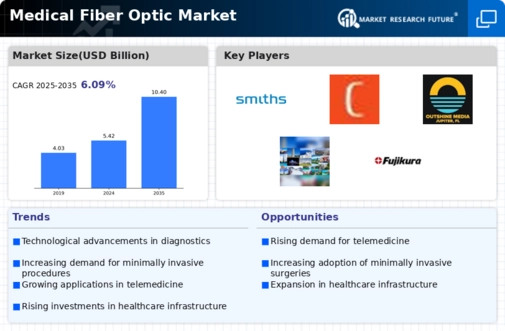Market Growth Projections
The Global Medical Fiber Optic Market Industry is poised for substantial growth, with projections indicating a market value of 5.42 USD Billion in 2024 and an anticipated increase to 10.4 USD Billion by 2035. This growth trajectory suggests a compound annual growth rate of 6.09% from 2025 to 2035. The expansion is driven by various factors, including technological advancements, increasing healthcare demands, and the integration of fiber optics in medical applications. As the industry evolves, it is likely to witness significant innovations and improvements, further enhancing its value proposition in the healthcare sector.
Expansion of Healthcare Infrastructure
The expansion of healthcare infrastructure across various regions is a pivotal driver for the Global Medical Fiber Optic Market Industry. As countries invest in modernizing their healthcare facilities, the integration of advanced technologies, including fiber optics, becomes essential. New hospitals and clinics are increasingly equipped with fiber optic systems to improve diagnostic capabilities and surgical precision. This trend is particularly pronounced in emerging economies, where healthcare access is improving. The anticipated growth in healthcare infrastructure is likely to support the market's trajectory, with projections indicating a market value of 10.4 USD Billion by 2035, reflecting the long-term potential of fiber optic technologies in healthcare.
Increasing Prevalence of Chronic Diseases
The Global Medical Fiber Optic Market Industry is significantly influenced by the rising prevalence of chronic diseases, such as cardiovascular disorders and cancer. These conditions necessitate advanced diagnostic and treatment modalities, where fiber optic technology is increasingly utilized. For instance, fiber optic endoscopy is becoming a standard practice for early detection and monitoring of various cancers. The growing patient population requiring regular monitoring and treatment options is driving the demand for fiber optic solutions. This trend is expected to contribute to the market's expansion, as healthcare providers seek efficient and effective tools to manage chronic conditions, thereby enhancing patient outcomes.
Rising Demand for Minimally Invasive Procedures
The Global Medical Fiber Optic Market Industry is experiencing a notable surge in demand for minimally invasive surgical procedures. This trend is largely driven by the increasing preference for techniques that reduce patient recovery time and minimize surgical risks. Fiber optic technology plays a crucial role in these procedures, facilitating high-quality imaging and precise surgical interventions. As a result, the market is projected to reach 5.42 USD Billion in 2024, reflecting the growing reliance on fiber optics in surgical applications. The shift towards outpatient care and the need for efficient healthcare solutions further bolster this demand, indicating a robust growth trajectory for the industry.
Technological Advancements in Fiber Optic Systems
Technological innovations in fiber optic systems are significantly shaping the Global Medical Fiber Optic Market Industry. Advancements such as improved light transmission capabilities, enhanced durability, and miniaturization of fiber optic components are enabling more effective diagnostic and therapeutic applications. These innovations are particularly evident in endoscopic procedures, where high-resolution imaging is paramount. The continuous evolution of fiber optic technology not only enhances the quality of medical procedures but also contributes to cost-effectiveness. As the industry adapts to these advancements, it is likely to see a compound annual growth rate of 6.09% from 2025 to 2035, underscoring the potential for sustained growth.
Growing Focus on Telemedicine and Remote Monitoring
The Global Medical Fiber Optic Market Industry is also benefiting from the growing focus on telemedicine and remote patient monitoring. As healthcare systems evolve to incorporate digital solutions, fiber optic technology plays a critical role in ensuring high-speed data transmission and reliable connectivity. This is particularly important for remote diagnostics and consultations, where real-time data sharing is essential. The increasing adoption of telehealth services is expected to drive demand for fiber optic systems, as healthcare providers seek to enhance patient engagement and streamline care delivery. This trend indicates a promising future for the industry, aligning with broader shifts towards digital healthcare solutions.






